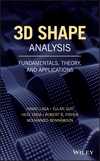3D Face Recognition
Summary
This chapter reviews some of the recent advances in 3D face recognition. It first presents the various 3D facial datasets and benchmarks that are currently available to researchers and then discuss the challenges and evaluation criteria. The chapter reviews the key 3D face recognition methods. There are two scenarios of 3D face recognition, namely, 3D face verification and 3D face identification. A table lists some of the identification approaches. These approaches can be categorized according to the features they use, or based on the type of classification approach that they use. The chapters groups existing methods into two categories: holistic approach and local approach. Holistic-based 3D face recognition approaches, also called global approaches, treat the face as a whole and work directly on its entire 3D surface. Local feature-based matching methods use local surface proprieties, such as points, curves, or regions, of the 3D faces.



